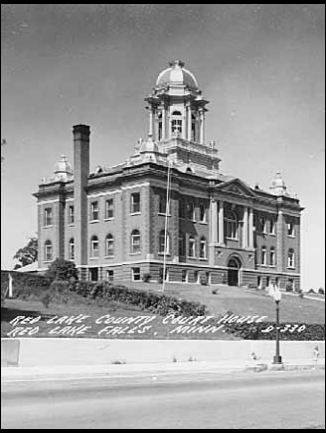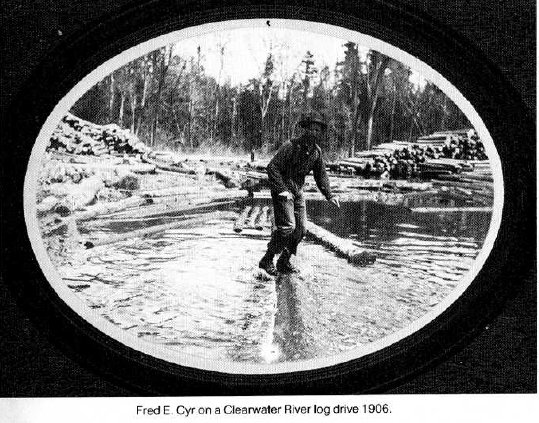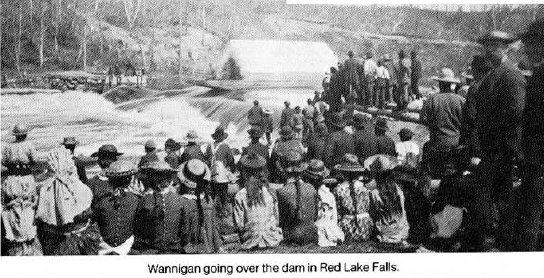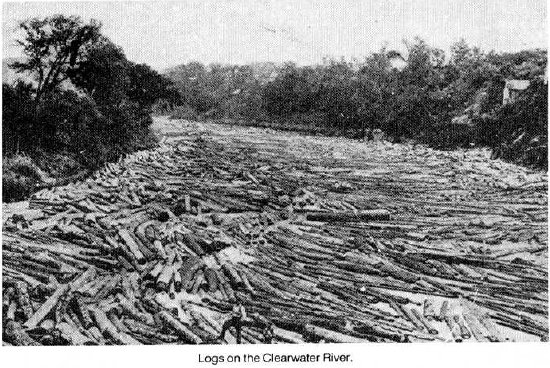 |
|
|
Fred E. Cyr was born on the banks of the Clearwater River one mile from Red Lake Falls in the year 1882, the son of Joseph Cyr.The story of Fred's young logging days were tape recorded in 1954 by historian Dr. Charles Vandersluis of Bemidji and retold for the History of Red Lake County.
As a young boy I played on the logs coming down past our home on the Clear-water river near where it runs into the Red Lake river, and got to be well acquainted with the drivers. We could tell when the logs were coming because the water roiled and the next day the chips would come down, and then it wouldn't be long until the logs would come. We were always anxious to see the drivers. They had calks on their shoes and we kids looked at the tracks on the shore and knew that someday we would be log drivers.

When I first started to drive logs, I was hired by J. C. Parker who came to Red Lake Falls about 1900 to recruit men because his drive was hung up in a big meadow someplace. I think we got $2.00 a day (with our food) and we worked from 5 a.m. to 8 at night. We got four meals a day and the best food there was. It was hauled by team right alongside the river or was bought from the farmers as the drive proceeded. Sometimes a cow bought from a farmer would be killed and eaten fresh. We had wanigans which were houses built on flat bottomed boats. Half of each house was used for cooking and the other half for sleeping quarters. There were double bunks with an aisle in the center. These boats were quite long but not very high. sometimes we had to cut them down even more to get them under bridges. The mosquitoes were the worst trouble. We couldn't sleep without mosquitoe nets which we got in Red Lake Falls, readymade. Lice also became a problem in the summer on the wannigans, and we often spent time to "read our shirts to look for lice in seams."

At the beginning of a drive, Parker would hire anybody who wanted a job. the men would go to work and he would watch to see how they did. The next morning he "passed the sieve". that is, he pointed out those he did not want and said' "You don't have to put up your lunch today" and they knew what that meant. After he picked a good crew, and after they got below the dam at Clearwater Lake, he never fired them.
Logs were boomed and towed across Clearwater Lake with a steam outfit and growser. These logs were all stamped and bark-marked. I stamped some of them myself when I worked in the woods. The stamp mark would compress the grain in three inches from each end of the log, so if the log was sawed off near either end, the mark would still show. It was made with an axe and maybe it was 4 X, or something like that. I remember that the Red Lake Falls sawmill had a crow foot as a bark mark. The logs were generally put into the river all along the bank. In the spring the first thing one had to do was to break up the landings and open up the river. It was tough work as it was done when it was still cold, just when the ice was beginning to break up. Drivers would have to wade in the water perhaps up to their waists to get at the logs; oftentimes the water would freeze at night. A lot of fellows quit, but the bunch of us from Red Lake Falls stuck. After the logs got started down the river into Clearwater Lake, it was a snap.
The wanigans, 8 or 10 of them, had been built in readiness for the drive. It was 175 miles from Clearwater Lake to Red Lake Falls. Every few days a crew with a wanigan would start down the river, until there would be as many as ten crews scattered along a hundred miles of river.
There was no dam below Clearwater dam until we came to Plummer, and there was no sorting work on the Clearwater. The first sorting gap was on the Red Lake River two miles above Crookston in a flow-age where the water was quiet.
We were armed with pike poles and occasionally peavies, which differ from cant hooks by having a spike in the center. Peavies were used mainly in log jams, and shear booms were often put along the banks so when the logs hit them, they wouldn't stick in the bank and cause a log jam. A shear boom was a peeled log with a peg driven into it tied to shore. We usually didn't have much trouble until we got to Plummer. From Plummer on down to Crookston the water was pretty swift, and it was quite a job breaking up the jams with peavies.
The low water on the Clearwater was on the rapids, which were especially rocky and shallow from Terrebonne to Red Lake Falls. We had to roll the logs over and over, and it was slow and expensive. It is ten miles by land and 20 miles by river from Terrebonne to Red Lake Falls. If we had enough rain it wasn't bad, but sometimes it was dry and we were hung up.

There was a sawmill at Red Lake Falls later on, and logs came Jo that mill from the Red Lake River. The Clearwater logs went to Crookston and Grand Forks. About 1900, after we moved into Red Lake Falls, I visited there, and it was booming and the sawmill had just started. There was also a big sawmill at St. Hilaire.
The Red Lake River is fairly wide, but crooked. As I remember, the water used to flow over the banks, and we had to use pike poles to get the logs out of the logans (where the water backs up in a depression alongside the river and doesn't move.) If a log gets in a place like that, it has to be poled out. We kept ourselves out of the water by walking logs, and boats or big bateaus would come along to pick up the men. Sometimes we carried a knapsack with food on our backs. If we fell into the water, we would have "mush" and would have to eat it.
I think that logging on the Clearwater wound up around 1908. I worked with logs until 1911 or so. At that time things were pretty well cleaned up and there wasn't anymore driving to speak of. It was also about that time they closed the mills at St. Hilaire and at Thief River Falls.
Back to Red Lake County History